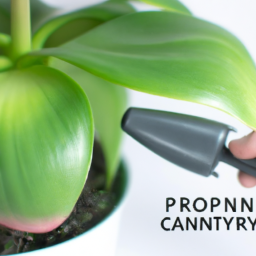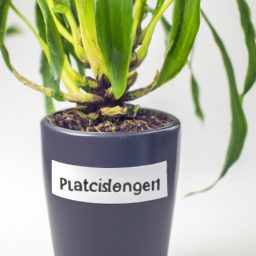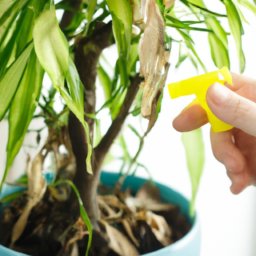
Are you tired of seeing your beloved plants suffer from diseases and pests? If so, you’re in the right place. In this blog post, we’ll discuss preventive plant care measures and how they can help you keep your plants healthy. By implementing these simple yet effective strategies, you can ensure that your plants thrive and flourish, free from common ailments that can hinder their growth. So, let’s dive in and explore the world of preventive plant care measures, and discover how you can provide the best possible care for your green companions.
The Importance of Preventive Plant Care: Why Keeping Your Plants Healthy Matters
Plants are not just mere decorations in our homes or gardens; they play a vital role in our environment. They provide us with fresh air, beautify our surroundings, and even contribute to our overall well-being. Therefore, it is crucial to take preventive plant care measures to keep them healthy and thriving. In this article, we will explore the significance of preventive plant care and why it should be a priority for every plant enthusiast.
The Benefits of Preventive Plant Care
Preventive plant care involves implementing measures to maintain the health and vitality of your plants before any major issues arise. By taking proactive steps, you can prevent diseases, pests, and other problems that can harm your plants. Here are some key benefits of preventive plant care:
1. Enhanced Plant Growth: When you provide your plants with proper care and attention, they will grow stronger and healthier. Regular watering, appropriate lighting conditions, and balanced nutrition are all essential factors in promoting optimal plant growth.
2. Disease Prevention: Preventive plant care measures can help you identify and address potential disease issues before they become severe. Regularly inspecting your plants for signs of diseases such as wilting, discoloration, or unusual growth patterns, allows you to take immediate action and prevent the spread of diseases to other plants.
3. Pest Control: By implementing preventive measures, you can keep pests at bay. Regularly cleaning your plants, removing dead leaves, and using organic pest control methods can significantly reduce the risk of infestations. This ensures that your plants remain healthy and vibrant.
Implementing Preventive Plant Care Measures
Now that we understand the importance of preventive plant care, let’s delve into some effective measures you can take to keep your plants healthy:
1. Provide Adequate Watering: Watering is a fundamental aspect of plant care. Different plants have varying water requirements, so it is essential to research and understand the specific needs of your plants. Overwatering can lead to root rot, while underwatering can cause dehydration and stunted growth. Ensure you water your plants consistently, allowing the soil to dry slightly between watering sessions.
2. Ensure Proper Lighting: Light is essential for photosynthesis, the process by which plants convert sunlight into energy. Understanding the lighting requirements of your plants is crucial for their overall health. Some plants thrive in direct sunlight, while others prefer indirect or shaded areas. Place your plants accordingly and consider using artificial lighting for indoor plants if natural light is limited.
3. Maintain Optimal Humidity: Humidity levels can significantly impact plant health, especially for tropical plants that require higher humidity. Monitor the humidity levels in your plant’s environment and use a humidifier or pebble trays to increase humidity if necessary. Conversely, if the air is too humid, ensure proper ventilation to prevent fungal growth.
4. Regularly Inspect for Pests and Diseases: Keep a close eye on your plants for any signs of pests or diseases. Look for visible pests, such as aphids or spider mites, as well as symptoms like yellowing leaves, spots, or wilting. Early detection allows you to take immediate action, such as using organic pest control methods or applying appropriate treatments to prevent the spread of diseases.
5. Provide Adequate Nutrition: Plants require essential nutrients to thrive. Use high-quality fertilizers to provide your plants with the necessary nutrients, ensuring a balanced diet. Research the specific nutritional needs of your plants and fertilize them accordingly, avoiding over-fertilization, which can lead to nutrient imbalances and damage to the roots.
6. Prune and Trim Regularly: Pruning and trimming are essential for maintaining the shape, size, and overall health of your plants. Remove dead or diseased leaves, branches, or flowers to promote new growth and prevent the spread of diseases. Additionally, pruning helps improve air circulation, reducing the risk of fungal infections.
7. Clean and Sterilize: Regularly clean your plant’s containers, tools, and surrounding areas to prevent the accumulation of dirt, dust, and potential pathogens. Sterilize your tools before using them on different plants to avoid cross-contamination. Cleanliness plays a crucial role in preventing the spread of diseases and maintaining a healthy plant environment.
By following these preventive plant care measures, you can ensure the long-term health and vitality of your plants. Remember, prevention is always better than cure when it comes to plant care. So, invest time and effort in maintaining a healthy plant environment, and you will be rewarded with thriving, beautiful plants that bring joy to your surroundings.

Essential Preventive Plant Care Measures: Tips and Techniques for Maintaining Plant Health
Plants are a beautiful addition to any home or garden. They provide us with fresh air, natural beauty, and a sense of tranquility. However, just like any living organism, plants require care and attention to thrive and stay healthy. In this article, we will discuss essential preventive plant care measures that will help you maintain the health of your plants.
Understanding Plant Health
Before diving into the preventive measures, it is important to understand what constitutes plant health. Healthy plants are characterized by vibrant foliage, strong stems, and an overall robust appearance. They are resistant to diseases, pests, and environmental stressors. By implementing preventive measures, you can ensure that your plants remain healthy and continue to flourish.
1. Provide Adequate Lighting: Light is one of the most crucial factors for plant growth. Different plants have varying light requirements, so it is important to understand the specific needs of your plants. Most plants thrive in bright, indirect light, while others may require direct sunlight. Ensure that your plants are placed in an area that receives the appropriate amount of light to promote healthy growth.
2. Watering: Proper watering is essential for plant health. Overwatering can lead to root rot and other fungal diseases, while underwatering can cause dehydration and wilting. The key is to find the right balance. Check the moisture level of the soil regularly and water your plants when the top inch of soil feels dry. Consider using a moisture meter to accurately determine the watering needs of your plants.
3. Fertilization: Plants require essential nutrients for growth. Regular fertilization helps replenish these nutrients and promotes healthy foliage and flowering. Choose a balanced fertilizer that contains nitrogen, phosphorus, and potassium in the appropriate ratios. Follow the instructions on the fertilizer packaging for the correct application method and frequency.
Pest and Disease Prevention
Pests and diseases can wreak havoc on your plants if left unchecked. Implementing preventive measures can help protect your plants from these threats.
1. Regular Inspections: Conduct regular inspections of your plants to identify any signs of pests or diseases. Look for chewed leaves, discolored spots, or wilting. Early detection can prevent the spread of pests or diseases to other plants.
2. Proper Plant Placement: Different plants are susceptible to different pests. By strategically placing your plants, you can reduce the risk of infestations. For example, avoid placing plants that are prone to aphids near plants that attract ants, as ants can transport aphids to other plants.
3. Natural Pest Control: Consider using natural pest control methods such as introducing beneficial insects like ladybugs or using organic insecticidal soaps. These methods are effective in controlling pests without harming the environment or beneficial insects.
Environmental Considerations
Environmental factors play a significant role in plant health. By considering these factors, you can create an optimal environment for your plants to thrive.
1. Temperature and Humidity: Different plants have different temperature and humidity requirements. Ensure that the temperature and humidity levels are within the optimal range for your plants. Use a thermometer and a hygrometer to monitor these conditions.
2. Air Circulation: Proper air circulation is essential for preventing the buildup of moisture, which can lead to fungal diseases. Ensure that there is adequate airflow around your plants by spacing them appropriately and avoiding overcrowding.
3. Seasonal Adjustments: Plants have different needs during different seasons. Adjust your care routine accordingly. For example, reduce watering during the winter months when plants are in their dormant phase.
By following these essential preventive plant care measures, you can ensure the health and vitality of your plants. Remember to observe your plants closely, as each plant may have its own specific requirements. With proper care and attention, your plants will thrive and bring joy to your home or garden for years to come.

Common Plant Diseases and How to Prevent Them: A Guide to Protecting Your Plants
Keeping your plants healthy and disease-free is essential for any gardener or plant enthusiast. Plants, just like humans, can fall victim to various diseases that can hinder their growth and overall health. In this guide, we will explore some of the most common plant diseases and provide you with preventive measures to ensure the well-being of your beloved plants.
1. Fungal Diseases
Fungal diseases are among the most prevalent plant diseases, affecting a wide range of plant species. These diseases are caused by various types of fungi that thrive in specific environmental conditions. Here are a few preventive measures to keep fungal diseases at bay:
Proper Watering: Overwatering can create a favorable environment for fungal growth. Ensure that you water your plants at the base and avoid wetting the foliage excessively. Additionally, water in the early morning to allow leaves to dry out during the day.
Adequate Air Circulation: Good air circulation helps prevent the buildup of moisture, which can contribute to fungal growth. Avoid overcrowding your plants and prune them regularly to maintain proper spacing.
Clean Gardening Tools: Fungal spores can easily spread through contaminated tools. Regularly clean and disinfect your gardening tools to prevent the transmission of diseases between plants.
2. Bacterial Infections
Bacterial infections can cause significant damage to plants, leading to wilting, discoloration, and even death. To protect your plants from bacterial diseases, follow these preventive measures:
Sanitize Pruning Equipment: Similar to fungal diseases, bacteria can spread through contaminated tools. Before and after pruning, disinfect your tools using a solution of bleach and water. This will help minimize the risk of bacterial transmission.
Proper Plant Nutrition: Providing your plants with balanced nutrition strengthens their immune system, making them more resistant to bacterial infections. Ensure that you use high-quality soil and fertilizers suitable for your plant’s specific needs.
Remove Infected Plant Parts: If you notice any signs of bacterial infection, such as lesions or oozing sap, promptly remove and dispose of the affected plant parts. This will prevent the spread of bacteria to healthy areas.
3. Viral Diseases
Viral diseases in plants are caused by various viruses that can severely impact their growth and productivity. While there are no specific treatments for viral infections, prevention is key. Here are some preventive measures:
Practice Good Hygiene: Always wash your hands thoroughly before and after handling plants to minimize the risk of viral transmission. Additionally, avoid working with plants when you have open cuts or sores.
Control Insect Vectors: Many viral diseases are transmitted through insect vectors, such as aphids and whiteflies. Implement integrated pest management strategies to control these insects and reduce the risk of viral infections.
Quarantine New Plants: Before introducing new plants to your garden, isolate them for a period of time to monitor for any signs of viral diseases. This will prevent the spread of viruses to your existing plants.
By following these preventive measures, you can significantly reduce the risk of common plant diseases and ensure the health and longevity of your plants. Remember to always stay vigilant, observe your plants regularly, and take prompt action if you notice any signs of disease. Happy gardening!
In a Nutshell
Taking care of plants can be a rewarding and fulfilling experience, but it also requires some effort to keep them healthy and thriving. Preventive plant care measures are essential in ensuring the well-being of your plants, and they can save you from the disappointment of seeing your beloved greenery wilt away. So, let’s dive into some simple yet effective tips to keep your plants in the best shape possible.
Firstly, proper watering is crucial for plant health. Overwatering or underwatering can both be detrimental, so finding the right balance is key. Pay attention to the specific watering needs of each plant species, as they vary greatly. Additionally, it’s important to check the soil moisture regularly and adjust your watering schedule accordingly. Another preventive measure is regular inspection for pests and diseases. Catching any signs of trouble early on can prevent them from spreading and causing significant damage. Keep an eye out for yellowing leaves, spots, or any unusual growth patterns. If you spot any issues, take action promptly using organic pest control methods or consulting a professional if needed. By being proactive and implementing preventive plant care measures, you can ensure that your plants thrive and bring beauty and joy to your surroundings.
FAQ Roundup:
Q1: How often should I water my plants?
A1: The frequency of watering your plants depends on various factors such as the type of plant, its size, and the environmental conditions. As a general rule, you should water your plants when the top inch of soil feels dry to the touch. However, it’s important to avoid overwatering as it can lead to root rot and other issues. To determine the ideal watering schedule for your specific plants, it’s best to research their specific needs or consult a gardening expert.
Q2: What are some common signs of plant pests or diseases?
A2: Keeping an eye out for signs of plant pests or diseases is crucial for preventive plant care. Some common indicators include yellowing or browning leaves, spots or lesions on leaves or stems, wilting, stunted growth, and the presence of insects or webs. It’s important to regularly inspect your plants for any unusual changes and take appropriate measures to prevent the spread of pests or diseases.
Q3: How can I provide proper nutrition to my plants?
A3: Providing adequate nutrition is essential for maintaining healthy plants. You can achieve this by using organic fertilizers or compost to enrich the soil with essential nutrients. Additionally, foliar feeding with a diluted liquid fertilizer can help provide a quick nutrient boost. It’s important to follow the recommended dosage instructions and avoid over-fertilizing, as it can harm the plants. Understanding the specific nutritional needs of your plants will help you tailor the feeding regimen accordingly.
Q4: How can I protect my plants from extreme weather conditions?
A4: Extreme weather conditions can pose a threat to your plants’ health. To protect them, you can take several measures. During hot summers, provide shade or use mulch to retain moisture and regulate soil temperature. In cold winters, cover sensitive plants with frost blankets or move them indoors. During heavy rains or storms, ensure proper drainage to prevent waterlogging. By monitoring weather forecasts and taking proactive steps, you can safeguard your plants from the adverse effects of extreme weather.
Q5: How do I maintain proper hygiene for my plants?
A5: Maintaining good plant hygiene is vital for preventing the spread of diseases and pests. Start by regularly removing dead leaves, flowers, or any plant debris from the soil surface. This helps eliminate potential breeding grounds for pests and reduces the risk of fungal or bacterial infections. Additionally, clean your gardening tools before and after use to avoid transmitting any pathogens. If you notice any signs of diseases or pests, isolate the affected plants to prevent further contamination.

Lisa Chen is a seasoned indoor gardening expert and the author of several bestselling books on the topic. With a background in horticulture and urban farming, Lisa is dedicated to helping urban dwellers embrace the joys of cultivating green spaces indoors. Her detailed guides and hands-on tips empower readers to transform their living spaces into thriving plant sanctuaries.


